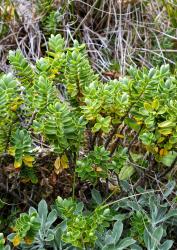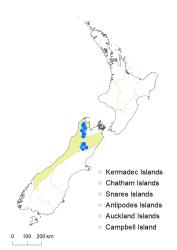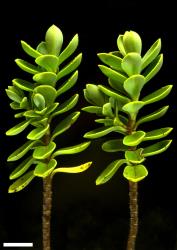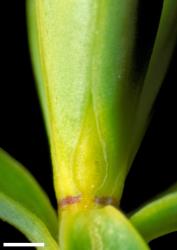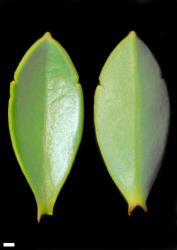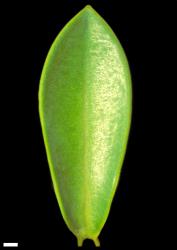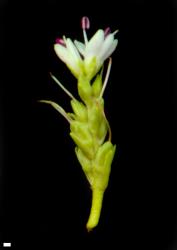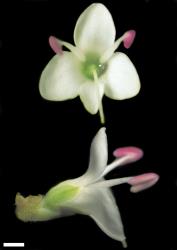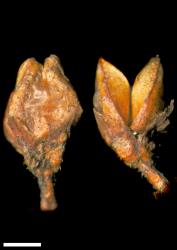- ≡ Hebe crenulata Bayly, Kellow & de Lange in Bayly et al., New Zealand J. Bot. 40: 592 (2002)
Spreading low or bushy shrub to 1 m tall. Stems spreading or ascending to erect, eglandular-pubescent; hairs bifarious. Leaf bud distinct, its leaves appressed at margins until fully grown; sinus acute. Leaves opposite-decussate, erecto-patent to reflexed; lamina coriaceous, usually oblanceolate to obovate, less often elliptic, 6–25 mm long, 3–8 mm wide, dull or slightly glossy green above, dull, glaucescent to glaucous beneath; midrib evident; surfaces glabrous except for eglandular hairs, and sometimes also short glandular hairs as well along midrib above; margin glabrous and minutely papillate, or sometimes clusters of minute glandular hairs in sinuses of teeth, entire or shallowly toothed in 1–3 pairs; apex obtuse to acute and plicate-mucronate; base abruptly cuneate; petiole 1.0–2.7 mm long. Inflorescence a lateral spike or raceme, sometimes tripartite, 9–31 mm long; flowers crowded, 4–16, female or bisexual on separate plants, ⚥ > ♀; bracts opposite-decussate, linear to deltoid, > pedicels, often equalling the calyx; pedicels absent or erecto-patent, 0–1.5 mm long, eglandular-hairy all around, often with very short glandular hairs as well. Calyx lobes 4, sub-acute to acute, or sometimes obtuse, 1.8–3.0 mm long, sub-equal, mixed glandular- and eglandular-ciliolate. Corolla 6–9 mm diameter; tube white, 1.4–1.6 mm long, glabrous, about = calyx; lobes 4, white, sub-erect to recurved, unequal, elliptic to ovate, 3–4 mm long, obtuse; nectar guides absent. Stamen filaments white, 2.5–6.5 mm long; anthers magenta. Style glabrous, 5–7 mm long. Capsule latiseptate, sub-acute to obtuse, glabrous, 3.2–4.0 mm long, 2.2–3.2 mm at widest point. Seeds elliptic to oblong, flattened, finely wrinkled, pale brown, 1.5–1.9 mm long.
V. rigidula, V. cryptomorpha, and V. cockayneana plants have similar discolorous leaves, a narrow, acute sinus in the bud, and opposite-decussate flower arrangement; these are most likely to be confused with V. simulans plants.
V. cockayneana, V. cryptomorpha, and V. simulans also share coarse, bifarious branchlet hairs and short, tubed corollas with obtuse lobes. V. cockayneana is confined to the south-west South Island, but the distributions of V. cryptomorpha and V. simulans come close to each other, but do not overlap, in south-east Nelson.
Plants of V. cryptomorpha and V. cockayneana may be distinguished from V. simulans by having leaves that are almost never toothed or incised. However, in the southern populations of V. simulans, plants have leaf margins more sparsely toothed and a higher proportion of leaves with entire margins; such plants can be hard to distinguish from plants of V. cryptomorpha. Both V. cryptomorpha and V. simulans have very dense stomata on the leaf underside. On the upper surface there are few stomata, and these are weakly visible and more distant.
Plants of V. rigidula have corolla tubes that are about twice as long as the calyx, and they usually have tripartite inflorescences.
Plants of several other species of Veronica in north-west South Island are small-leaved shrubs with glaucous leaves. Of these, V. topiaria and V. albicans plants are easily distinguished from V. simulans because they lack a sinus in the vegetative bud. V. baylyi and V. societatis plants have a sinus in the vegetative bud, but their leaves are olive-green to glaucous equally on both surfaces.
In spite of its close similarities to V. cryptomorpha, recognition of V. simulans as a distinct species is supported by its chromosome number and flavonoid chemistry.
South Island: Western Nelson (west of the Motueka River from Douglas Range southwards), Westland (Braeburn Range, Spenser Mountains), Marlborough (St James Range, Poplars Range).
Sub-alpine shrubland and grassland, often on shallow soils in rocky sites. Recorded elevations range from 900 to 1660 m.
Flowers: December–February; fruits: January–April, persisting all year.
2n = 80 (see Bayly & Kellow 2006, as Hebe crenulata).
Veronica simulans is classified in V. subg. Pseudoveronica sect. Hebe and the informal group “Apertae” (small-leaved) (Albach & Meudt 2010; Bayly & Kellow 2006). Phylogenetic studies based on ITS sequence data place V. simulans in a large and unresolved clade with many similar species such as V. cryptomorpha, V. cockayneana, and V. baylyi. Its very close similarities to V. cryptomorpha suggest they might be related.
Identification of V. simulans is difficult because there is very little morphological difference between it and V. cryptomorpha. Their species status depends instead on different flavonoid profiles and chromosome numbers, which combine to provide evidence that these are two independent and allopatric lineages.
The seeds were described from very limited material and might not represent the range present.



